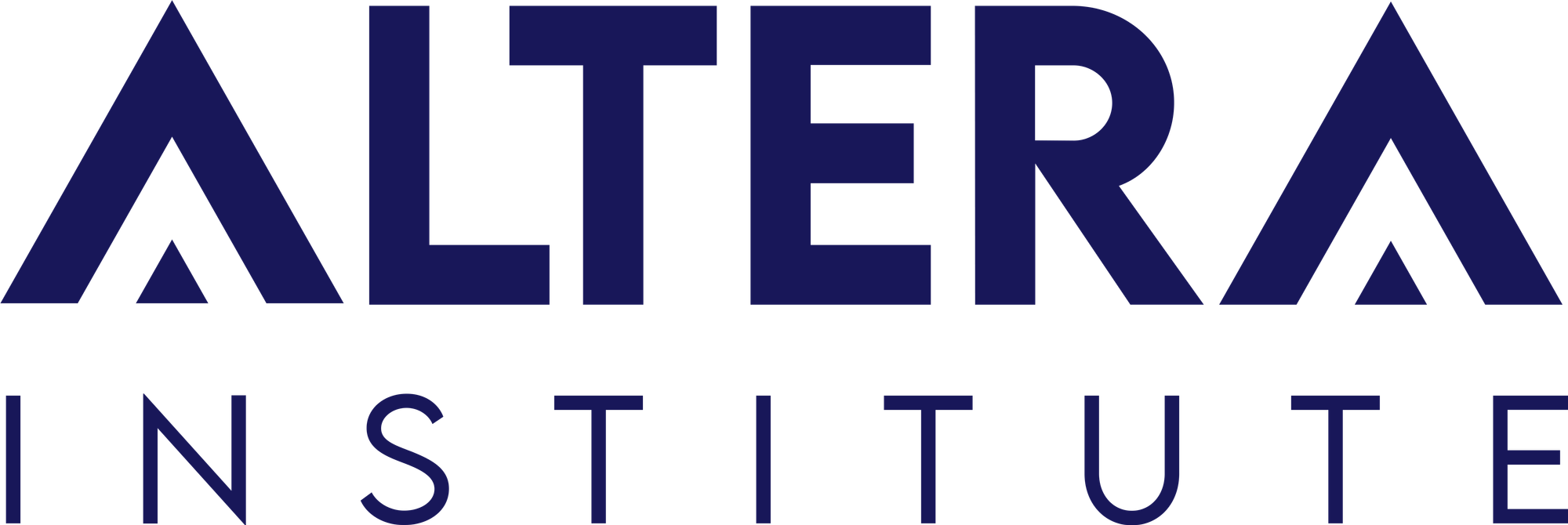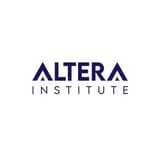What is the Scope of Performance Management?
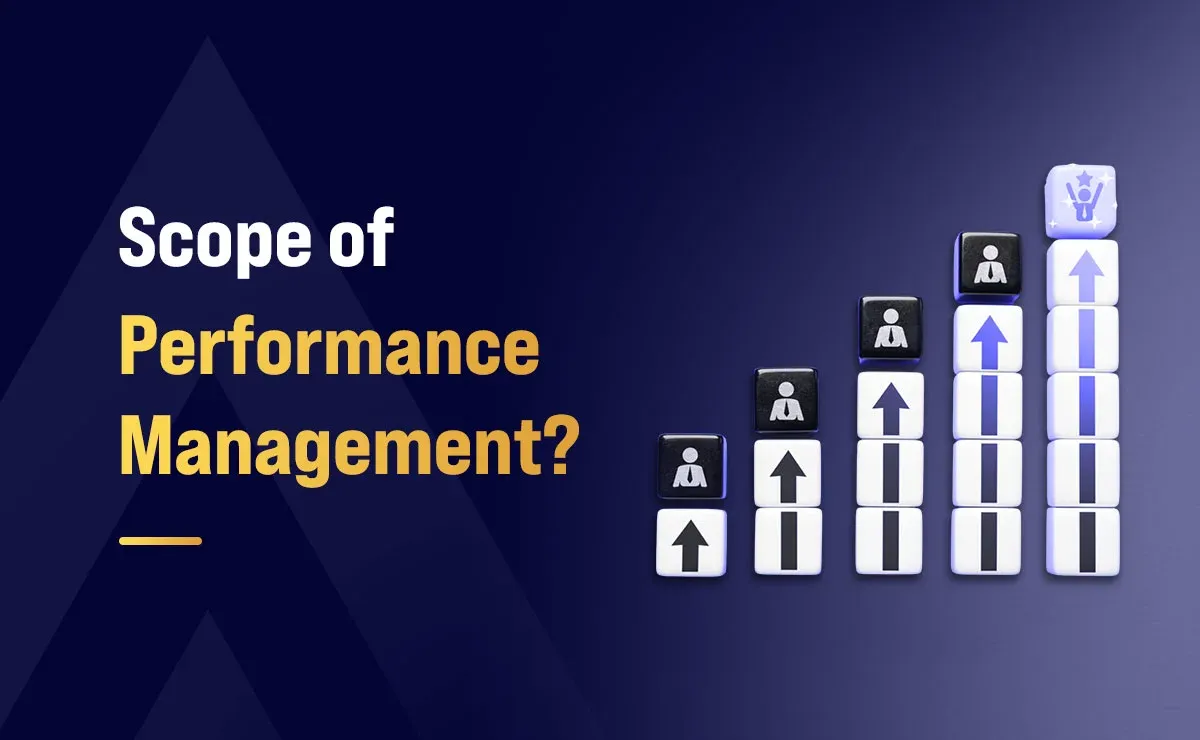
Performance management is an organized system that aligns personal efforts and corporate objectives to increase effectiveness, motivation, and productivity. It includes establishing work objectives, setting performance criteria, assessing progress, reviewing results, and rewarding accomplishments.
Michael Armstrong and Angela Baron, who wrote the book “Performance Management and Development” back in 2008, defined performance management as a "systematic process for improving organizational performance by developing the performance of individuals and teams."
Performance management helps the organization monitor, analyze, and enhance employee performance to achieve greater efficiency in achieving its goals. At Altera Institute, students are taught to use these techniques in practice, skills that support career development and placement. Explore how our programs equip you to succeed as a performance manager.
This definition underscores the crucial link between an organization's ability to achieve its goals and the performance of its human capital. This article explores the scope, importance, and objections of performance management in an organization.
What Is Performance Management?
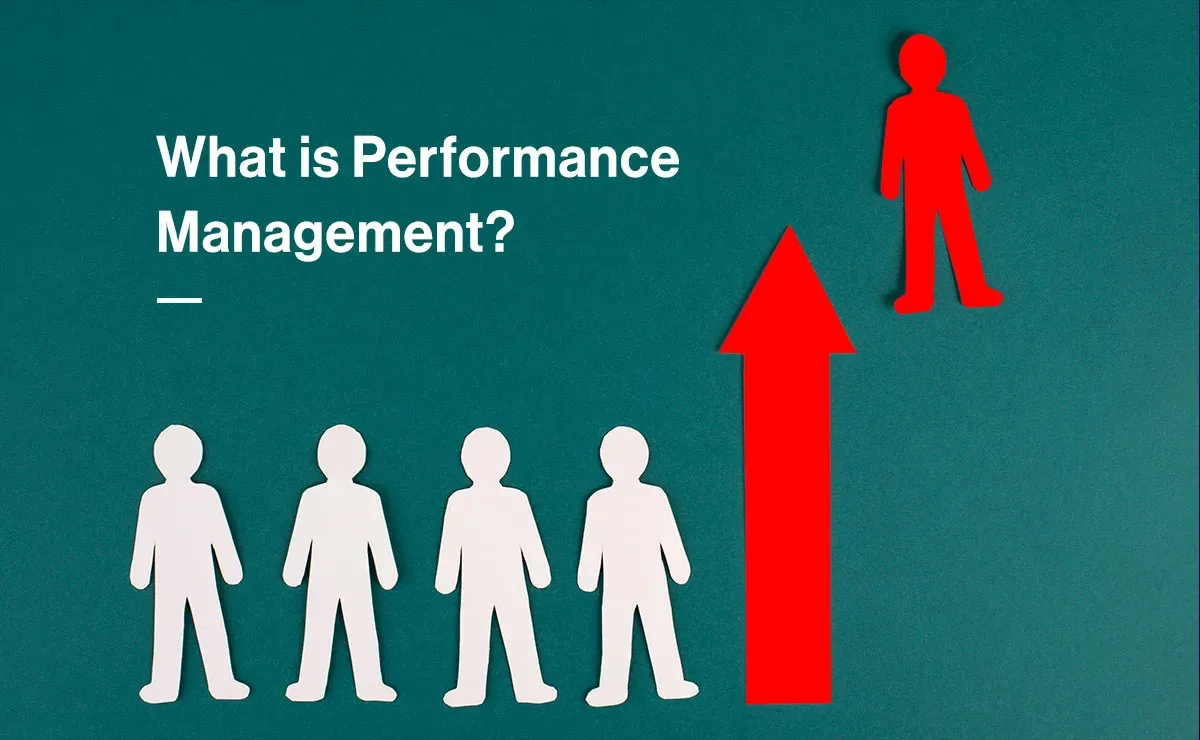
Performance management is an evolving, continuous cycle that guarantees employees are effectively working toward company targets. Unlike the outdated notion of performance reviews as a once-a-year event, modern performance management is an integrated and continuous approach.
This process includes defining precise goals, tracking progress, providing consistent feedback, and implementing adjustments to maximize efficiency. To illustrate, when a company has a well-organized performance management system with weekly check-ins and specific development plans, employee engagement and productivity regularly increase.
Key Functions of Performance Management
- Setting Defined Goals: Employees perform well when they are certain of what they are doing and what they are supposed to do.
- Constant Supervision: Performance monitoring keeps employees in line with business expectations.
- Positive feedback and Support: Continuous feedback helps the employees to develop and feel valued.
- Recognizing Achievements: Employees should be rewarded for their performance to motivate and retain them.
- Training and Development: Identifying competency gaps helps organizations plan skill development programs.
Now that we’ve covered the fundamentals, let’s dive deeper into the expansive reach of performance management.
Scope of Performance Management
Performance management is broad, encompassing areas that contribute to the success of employees and organizations. It is not limited to annual reviews but is a continuous loop of strategizing, monitoring, evaluating, and optimizing performance. The important aspects are as follows.
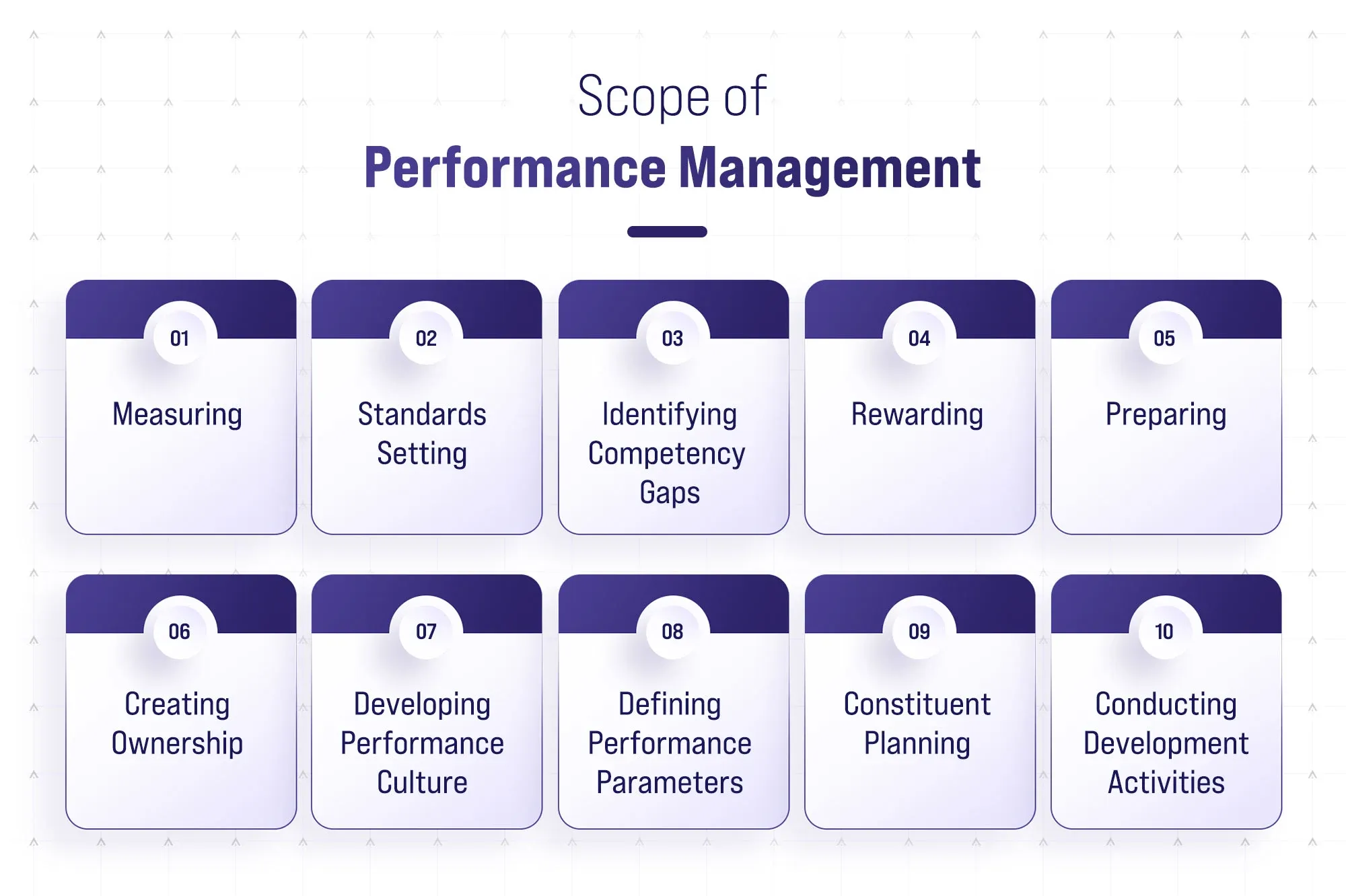
1. Measuring
A sound performance management system depends on performance evaluation. Organizations should be in a position to monitor employee input in terms of quantifiable measures, including:
- Key Performance Indicators (KPIs): These help assess employee productivity, efficiency, and their contribution to organisational goals.
- Balanced Scorecards: A holistic method that analyses financial results, client contentment, operational management, and skill development.
- 360-Degree Feedback: This is a multi-source evaluation technique in which feedback is collected from managers, colleagues, subordinates, and through self-evaluation.
Frequent performance measurements make the process more transparent, accountable, and strategic, enabling employees to see what is expected of them and enhance their performance.
2. Standards Setting
It is necessary to establish clear performance standards to achieve uniformity. Performance parameters are set in order to provide direction to employees on the desired output and behavior. These standards help create:
- Benchmarks for employee performance across different roles.
- Clear expectations for job responsibilities and expected outcomes.
- Principles of assessing employee performance in their individual roles.
As an example, sales professionals can be evaluated based on a monthly sales goal, and customer service representatives can be evaluated based on timeliness and customer satisfaction rates. Clear, measurable standards help employees know what to do and assist in meeting corporate objectives.
3. Evaluating
The employee performance evaluation process is a very important process that entails:
- Assessing employee contributions against predefined goals.
- Offering insightful guidance helps employees recognize their capabilities and areas for improvement.
- Conducting performance appraisals through structured review meetings.
Evaluation methods include:
- Self-Assessments: Employees are self-reflective.
- Managerial Reviews: Supervisors offer information on observations of their direct reports.
- Peer Reviews: Co-workers provide feedback on teamwork and cooperation.
A well-organised appraisal system guarantees fair, evidence-based, and impactful performance reviews that foster career advancement.
4. Identifying Competency Gaps
Pinpointing and bridging skill deficiencies is vital for both an employee’s career progression and organizational achievement. Competency gaps are the difference between the required skills for a job, and the actual skills employees possess.
Common ways to identify competency gaps include:
- Performance reviews and assessments.
- Skill gap analysis using training needs assessments.
- Employee self-reported areas of improvement.
Training, mentorship, and professional development strategies can address competency gaps among employees, enabling them to maximize their capabilities and perform better in their roles.
5. Rewarding
One of the main areas of performance management is ensuring that high-performing workers are rewarded and recognized for their work. Organizations are required to develop reward frameworks that are both appreciative of good performance and those that require improvement. Rewards can be financial, such as bonuses, or non-monetary, such as skill development.
6. Preparing
An appropriately designed performance management system equips employees with:
- Career development plans to become leaders in the future.
- Emerging business conditions with selective training programs.
- Adaptability coaching about changes within organizations.
Some of the preparation activities are:
- Succession strategies: Recognizing and developing potential talent into senior positions.
- Cross-skilling programs: Educating the workforce on various skills to enhance flexibility.
- Constant learning: Promoting upskilling in line with the changing business demands.
A structured preparation strategy ensures that employees and the organization stay ahead in a competitive market.
7. Creating Ownership
Ownership mentality fosters accountability and dedication. Employees should take ownership of their contributions and outcomes. Creating ownership involves:
- Encouraging employees to set their own goals aligned with company objectives.
- Giving employees autonomy in decision-making and problem-solving.
- Developing a sense of responsibility where employees see their success as directly linked to the company’s growth.
The ownership culture can be developed through the empowerment of employees who are given trust, responsibility and professional growth opportunities.
8. Developing Performance Culture
A strong performance culture ensures that all employees consistently strive to enhance their contributions. Key elements of a performance-driven culture include:
- A shared vision and values that prioritise excellence and continuous improvement.
- Transparent dialogue and feedback channels to promote employee participation.
- Recognition initiatives that celebrate and incentivise outstanding performance.
When workers operate in a performance-driven culture, they tend to be more invested, driven, and efficient.
9. Identifying Performance Parameters
Organizations need to establish clear performance parameters before executing performance management activities. It outlines the specific guidelines for considering an employee in terms of efficiency, effectiveness, and contributions. Examples include:
- Productivity Metrics: The efficiency of the completion of tasks by an employee.
- Quality of Work: The accuracy and effectiveness of job performance.
- Collaboration & Teamwork: How well an employee interacts with colleagues.
- Innovation & Problem-Solving: Contributions to process improvements and creative solutions.
Establishing clear performance parameters can help organizations be fair, consistent, and aligned with business goals.
10. Constituent Planning
The performance management should take into account all the members of an organization and not just the individual employees. This includes:
- Team Performance Management: Ensuring team goals align with company objectives.
- Departmental Performance Evaluations: Monitoring how different business units contribute to overall success.
- Organizational Performance Management: Measuring company-wide progress against strategic goals.
Effective constituent planning ensures that every level of the organisation is working towards a common vision and mission.
11. Conducting Development Activities
Companies should dedicate resources to skill-enhancement programs to improve workforce expertise. Examples involve:
- Hands-on Training: Learning through real-world tasks in an actual work scenario.
- Workshops and Seminars: Specialized training on industry trends and technologies.
- Mentoring Programs: Senior professionals guiding junior employees.
- Case Studies & Management Games: Problem-solving exercises for leadership development.
Continuous learning and development help employees adapt to changes, strengthen their skills, and contribute to business growth.
What is the Importance of Performance Management?
Performance management is more than just a tool for annual evaluations—it is a strategic management approach to aligning individual efforts with organizational objectives while fostering a culture of continuous improvement.
Below are 7 key reasons why performance management is essential for organizations.
1. Goal Setting and Alignment
One of the most important functions of performance management is to help organizations and employees set clear, realistic, and achievable goals. Without clear goal setting, employees may lose focus, resulting in lower efficiency and commitment. Performance management aids goal alignment by:
- Ensuring the team's objectives match the organization's mission and strategic aims.
- Offering a system to monitor and evaluate progress toward goals.
- Guiding employees in setting personalized SMART (specific, measurable, attainable, relevant, and time-bound) objectives.
For example, a marketing specialist may aim to boost social media activity by 20% in a quarter. Successful performance management ensures that these goals are monitored, supported and adjusted accordingly.
2. Engagement and Communication
Employees thrive in organizations that recognize, appreciate, and engage them. An effective performance management system promotes open dialogue between employees and management to clarify job specifications. It enhances engagement by:
- Encouraging regular one-on-one feedback sessions and check-ins.
- Creating a mechanism to present grievances by employees and support them.
- Improving the connection between managers and employees fosters trust and cooperation.
For example, monthly feedback meetings allow employees to share their experiences, address challenges, and receive constructive guidance from supervisors, ultimately improving engagement.
3. Productivity and Performance
One of the primary reasons businesses implement performance management is to boost productivity. Employees who receive frequent evaluations and feedback remain more focused and productive. This enhances efficiency by:
- Highlighting each employee’s talents and development areas.
- Guaranteeing staff have access to the right tools and support to thrive.
- Encouraging accountability and motivating employees to meet performance expectations.
An example of this is to monitor productivity indices and discuss them with employees to understand where inefficiencies are occurring and to devise measures to enhance work processes, thereby increasing productivity and work quality.
4. Transparency and Fairness
An effective performance management system encourages transparency through clear identification of expectations, performance standards and procedures of evaluation. When employees are aware of how their contributions are rated and rewarded, they feel confident and secure. It promotes transparency by:
- Clearly outlining performance expectations and success metrics.
- Delivering a systematic approach to performance assessments and recognition.
- Ensuring fairness by using data-driven performance assessments rather than subjective opinions.
For example, when employees know how promotions, raises, and rewards are determined, they are more likely to stay motivated and engaged, fostering a positive workplace environment.
5. Continuous Skills Development
An effective performance management system helps managers identify skill gaps among employees and provides opportunities for continuous learning and growth. Businesses that emphasize staff growth are better positioned to retain top performers and stay ahead. It supports skill development by:
- Pinpointing areas where employees need additional training or skill enhancement.
- Encouraging professional development through mentorship, training programs, and workshops.
- Providing employees with structured career growth opportunities.
Examples include an organization introducing upskilling programs for its workers who will deal with newer technology or industry trends to keep them relevant and a worthwhile investment for the organization.
6. Identification & Retention of the Best Talents
Performance management helps organizations reward the best performers, which increases morale and motivation. It should appreciate employees as this creates loyalty, commitment, and increased output. It encourages recognition by:
- Acknowledging achievements through financial and non-financial incentives.
- Offering career progression opportunities to high achievers.
- Fostering a culture of appreciation that inspires other employees to perform better.
For example, recognizing an employee's outstanding contributions in team meetings, offering bonuses, or providing career advancement opportunities reinforces a culture where employees feel valued and motivated.
7. Leadership Development and Succession
Performance management is key to cultivating future leaders and securing a steady leadership succession plan. Identifying employees with leadership potential and nurturing their skills helps organizations stay resilient and adaptable. It aids leadership development by:
- Helping managers identify employees with leadership qualities.
- Providing structured training and mentorship opportunities for future leaders.
- Ensuring business continuity by preparing employees for higher responsibilities.
For instance, a company may use performance management tools to track leadership potential, and then offer high-potential employees training programs, mentorship, and job rotations to prepare them for senior roles.
What are the Objectives of Performance Management?
The core objectives of performance management are listed below, and each is critical to maximizing employee performance and business success.
1. Setting and Defining Goals to Fulfil Company Objectives
Performance management also ensures that employees have clear, measurable objectives that are unique and aligned with the company's objectives. Establishing SMART objectives will help employees focus, improve performance, and become more responsible.
Clear goals also help employees understand their roles, the tasks to be prioritized, and make the best contribution to the organization's growth, thus enhancing the overall performance of the business.
2. Setting Ideal Expectations of Leaders and Team Members
A proper performance management system provides accurate roles to both managers and employees. Employees should have clear positions, and managers should offer achievable advice.
Written expectations guarantee transparency, accountability and efficiency, as employees remain motivated and productive and managers make informed decisions, which can lead to long-term organizational success.
3. Effective Communication between Teams and Individuals
Collaboration and alignment within teams cannot be achieved without open communication. Performance management promotes frequent feedback, communication, and group interactions, thereby enhancing workplace relationships.
Through fostering transparent communication and exchange of information, organizations can achieve greater interaction, lower levels of misunderstandings, and ensure that employees and teams strive to achieve mutual goals and business objectives.
4. Establishing Performance Standards
Defining clear performance benchmarks helps objectively measure employee efficiency. Performance criteria ensure workers understand expectations, recognize areas for improvement, and remain aligned with objectives.
An organized method of assessment and feedback minimizes bias, enhances fairness and allows organizations to be consistent, quality, and excellent in their workforce delivery.
5. Designing a Personalized Training and Development Roadmap
The performance management identifies skill gaps and develops a customized program to help increase employee competence. Continuous learning will also help in investment in career development, confidence and job satisfaction.
Individual development plans will also help employees acquire the relevant skills, thereby enhancing performance on the job and enabling the company to retain a competitive workforce.
6. Increasing Job Satisfaction and Motivation of the Employees
Rewarding performance enhances morale, interest and output. Performance management makes employees feel important by offering them incentives, promotions, and proper feedback.
A motivated workforce will make a positive difference in retention, work culture, and commitment rates, leading to the overall organizational success.
7. Promoting Constant Feedback and Enhancement
Constant feedback and performance reviews are utilized to improve skills and ensure employees follow the company's objectives. Positive feedback encourages development, responsibility, and improvement, avoiding ineffective work in the workplace and confrontations.
A culture of learning and flexibility will ensure that employees are engaged, motivated, and able to meet new business requirements.
8. Performance and Business Growth
Performance management makes sure that individual efforts lead to business success in the long run. An effective system boosts productivity, efficiency, and strategic decision-making.
Through constant performance tracking, companies can adjust to changes, maximize resources, and even maintain a high-achieving workforce, which helps them guarantee continued growth and a competitive edge.
Summing Up
The Performance management system is not merely an HR process but a strategic management model that can make an organization successful by integrating employees' activities with organizational goals. The company's success can be enhanced by setting attainable goals, fostering openness, providing coherent feedback, and recognizing achievements.
An effective performance management system does not just clarify role expectations but also promotes employee growth by helping them continuously upgrade their skills. Investment in this process breeds accountability, inspiration and optimum performance, leading to long-term success and competitive advantage.
By embracing a dynamic, continuous approach to performance management, organization's can ensure that both individuals and teams contribute effectively to long-term business growth while fostering an engaged, high-performing workforce.
